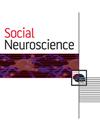自闭症谱系障碍儿童增强提问和启动的神经相关性:一项随机临床试验
IF 1.7
4区 医学
Q4 NEUROSCIENCES
引用次数: 0
摘要
摘要被诊断为自闭症谱系障碍(ASD)的儿童在社会交往的各个领域都面临挑战。本研究的目的是使用随机临床试验(RCT)设计,检验针对提问的关键反应治疗(PRT)对20名6-12岁自闭症男孩大脑活动的影响。根据年龄和平均话语长度(MLU)对被诊断为自闭症的言语儿童进行配对,并将其随机分为PRT干预组或照常治疗组。疗程是单独进行的,持续60分钟,每周3天,为期两个月。所有儿童在干预前后都接受了测试,以评估行为领域(问题、一般沟通技能和MLU),两组儿童在睁眼和闭眼休息状态下接受了10分钟的脑电图检查,以评估神经相关性。数据采用协方差分析法进行分析,并采用Mann-Whitney和Wilcoxon方法进行事后分析。与TAU组相比,PRT组在干预后观察到显著的行为改善,这与几个大脑区域的脑电图(EEG)振荡的变化相关。这项研究的结果支持了其他表明PRT后侧支神经变化的研究。本文章由计算机程序翻译,如有差异,请以英文原文为准。
Neural correlates of enhancing question asking and initiations in children with autism spectrum disorders: A Randomized Clinical Trial
ABSTRACT Children diagnosed with autism spectrum disorder (ASD) demonstrate challenges in various areas of social communication. The aim of this study was to examine the effect of Pivotal Response Treatment (PRT) targeting question-asking on brain activity in twenty 6–12-year-old autistic boys, using a Randomized Clinical Trial (RCT) design. Verbal children, diagnosed with autism, who lacked question asking in their communication were matched based on age and mean length utterance (MLU) and were randomly placed in either PRT intervention or treatment as usual (TAU) groups. Sessions were individually administered, lasting for 60 minutes 3 days a week for a two-month period. All children were tested before and after intervention to assess behavioral areas (questions, general communicative skills, and MLU) and both groups underwent electroencephalography for 10 minutes in open and closed eye resting-state conditions to assess neural correlates. Data were analyzed using covariance analysis and post-hoc using Mann-Whitney and Wilcoxon methods. Significant behavioral improvements in the PRT group were observed after intervention that correlated with changes in electroencephalography (EEG) oscillations at several brain regions compared to the TAU group. The results of this study support other studies suggesting collateral neural changes following the PRT.
求助全文
通过发布文献求助,成功后即可免费获取论文全文。
去求助
来源期刊

Social Neuroscience
医学-神经科学
CiteScore
3.40
自引率
5.00%
发文量
36
审稿时长
6-12 weeks
期刊介绍:
Social Neuroscience features original empirical Research Papers as well as targeted Reviews, Commentaries and Fast Track Brief Reports that examine how the brain mediates social behavior, social cognition, social interactions and relationships, group social dynamics, and related topics that deal with social/interpersonal psychology and neurobiology. Multi-paper symposia and special topic issues are organized and presented regularly as well.
The goal of Social Neuroscience is to provide a place to publish empirical articles that intend to further our understanding of the neural mechanisms contributing to the development and maintenance of social behaviors, or to understanding how these mechanisms are disrupted in clinical disorders.
 求助内容:
求助内容: 应助结果提醒方式:
应助结果提醒方式:


